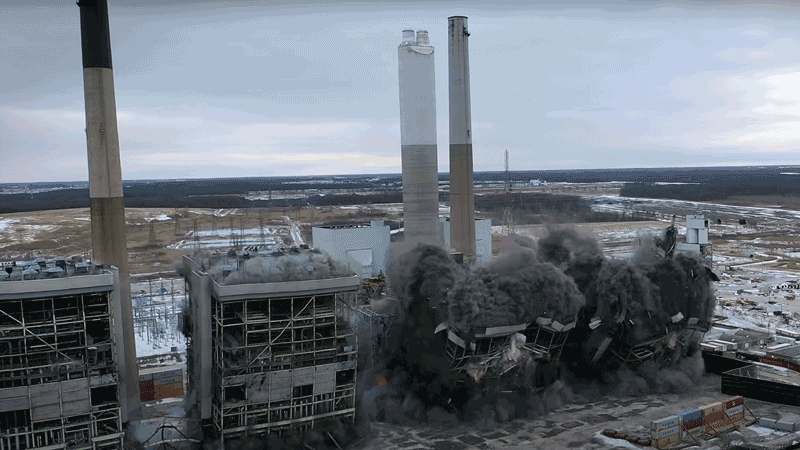It was all over in 30 seconds.
On Feb. 12 three smokestacks and four boiler buildings at the former Lambton generating station near Corunna in southwestern Ontario were brought to the ground by a series of detonations, effectively putting Ontario’s coal-burning power era further in the rearview mirror.
The demolition contractor hired by owner Ontario Power Generation (OPG) was Quebec’s Delsan-AIM. The window for the implosions opened this month and a couple of days before demolition day the weather predictions began to look favourable.
“We were very pleased how it all went. The key is the perfect weather conditions,” commented OPG’s director of information management Neal Kelly.
“Safety has to be our top priority. The debris has to go in the right direction for starters, we have to minimize the environmental impact, and we can’t have adverse impacts on the surrounding communities.”

The coal-fired Lambton GS was constructed along the St. Clair River and commissioned in 1969. It operated with four units, supplying 2,000 megawatts of power.
By 2000, coal-fuelled power plants produced about 25 per cent of Ontario’s energy needs. Then Ontario Premier Dalton McGuinty pledged to close Ontario’s coal plants in 2003 and by 2014 the transition was complete.
Lambton GS stopped operations on Sept. 20, 2013.
Delsan-AIM was appointed to the job in 2021, replacing another consultant, and the demolition and property mitigation is expected wrap up by the end of this year. Delsan-AIM had previously executed the demolition of the Nanticoke GS on Lake Erie in 2019.
The four boilers were each 67 metres in height. There were three concrete stacks, each 168 metres in height, and two other selective catalytic reduction structures, each 59 metres in height.
Approximately 3,500 pounds of explosives were installed in 2,000 locations over a three-week period prior to the implosion.“What you saw coming down were essentially the four boilers which were housed several storeys up and then the steel frame that was left in the building that was holding it up, that came down as well. And then obviously the three stacks.”
Kelly noted the wind had to be right to take the plume towards the St. Clair Parkway and away from residences in the U.S. across the St. Clair River.
“There’s no way we could send that dust cloud across into the U.S.,” he said.
Implosion was selected over mechanical demolition for several reasons, Kelly said. Dismantling the structures by hand would have taken a long time and would have required working at heights, which represents health and safety risks, he explained.
“This is the safest way to do it. It is a more economical way and now they can go and clean the site and return it to a brownfield.”
What remains on the property besides the rubble is a Hydro One electrical switchyard that is still in operation and a building where some OPG operations have continued. There is also an inland water channel that Kelly said is a “valuable piece of infrastructure as well, depending on what we end up doing with that site down the road.”
The explosions started at 7:45 a.m. Unlike the Nanticoke demolition, where guests and the media were invited on site, only essential personnel were allowed on to the property, in part due to the pandemic, Kelly said, including OPG and Delsan-AIM workers, emergency workers and Ministry of Environment regulators.
Local roads were closed for about three hours. The exclusion zone also included the St. Clair River with boats excluded.
The future use of the brownfield industrial site has not yet been determined.
To view the full video click here.
Follow the author on Twitter @DonWall_DCN.











Recent Comments